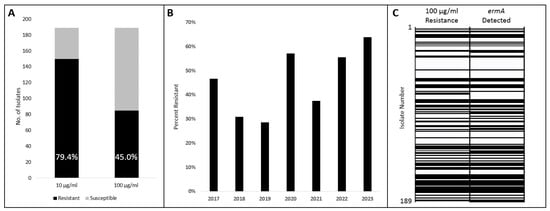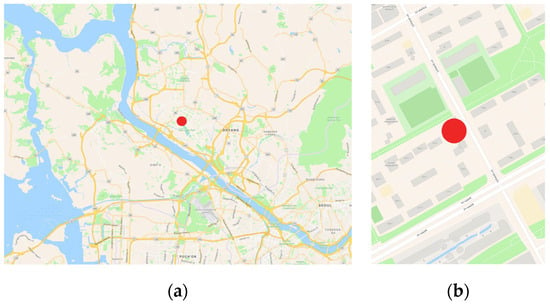Leaf chlorophyll content (LCC) is an important physiological index to evaluate the photosynthetic capacity and growth health of crops. In this investigation, the focus was placed on the chlorophyll content per unit of leaf area (LCC
A) and the chlorophyll content per
[...] Read more.
Leaf chlorophyll content (LCC) is an important physiological index to evaluate the photosynthetic capacity and growth health of crops. In this investigation, the focus was placed on the chlorophyll content per unit of leaf area (LCC
A) and the chlorophyll content per unit of fresh weight (LCC
W) during the tuber formation phase of potatoes in Northern Shaanxi. Ground-based hyperspectral data were acquired for this purpose to formulate the vegetation index. The correlation coefficient method was used to obtain the “trilateral” parameters with the best correlation between potato LCC
A and LCC
W, empirical vegetation index, any two-band vegetation index constructed after 0–2 fractional differential transformation (step size 0.5), and the parameters with the highest correlation among the three spectral parameters, which were divided into four combinations as model inputs. The prediction models of potato LCC
A and LCC
W were constructed using the support vector machine (SVM), random forest (RF) and back propagation neural network (BPNN) algorithms. The results showed that, compared with the “trilateral” parameter and the empirical vegetation index, the spectral index constructed by the hyperspectral reflectance after differential transformation had a stronger correlation with potato LCC
A and LCC
W. Compared with no treatment, the correlation between spectral index and potato LCC and the prediction accuracy of the model showed a trend of decreasing after initial growth with the increase in differential order. The highest correlation index after 0–2 order differential treatment is DI, and the maximum correlation coefficients are 0.787, 0.798, 0.792, 0.788 and 0.756, respectively. The maximum value of the spectral index correlation coefficient after each order differential treatment corresponds to the red edge or near-infrared band. A comprehensive comparison shows that in the LCC
A and LCC
W estimation models, the RF model has the highest accuracy when combination 3 is used as the input variable. Therefore, it is more recommended to use the LCC
A to estimate the chlorophyll content of crop leaves in the agricultural practices of the potato industry. The results of this study can enhance the scientific understanding and accurate simulation of potato canopy spectral information, provide a theoretical basis for the remote sensing inversion of crop growth, and promote the development of modern precision agriculture.
Full article
 IJMS
IMPACT
IJMS
IMPACT Applied Sciences
IMPACT
Applied Sciences
IMPACT Sustainability
IMPACT
Sustainability
IMPACT Sensors
IMPACT
Sensors
IMPACT JCM
IMPACT
JCM
IMPACT Materials
IMPACT
Materials
IMPACT Molecules
IMPACT
Molecules
IMPACT Energies
IMPACT
Energies
IMPACT Electronics
IMPACT
Electronics
IMPACT Remote Sensing
IMPACT
Remote Sensing
IMPACT Cancers
IMPACT
Cancers
IMPACT Nutrients
IMPACT
Nutrients
IMPACT Mathematics
IMPACT
Mathematics
IMPACT Foods
IMPACT
Foods
IMPACT Buildings
IMPACT
Buildings
IMPACT Polymers
IMPACT
Polymers
IMPACT Animals
IMPACT
Animals
IMPACT Water
IMPACT
Water
IMPACT Plants
IMPACT
Plants
IMPACT Agronomy
IMPACT
Agronomy
IMPACT Biomedicines
IMPACT
Biomedicines
IMPACT Processes
IMPACT
Processes
IMPACT Microorganisms
IMPACT
Microorganisms
IMPACT Diagnostics
IMPACT
Diagnostics
IMPACT Nanomaterials
IMPACT
Nanomaterials
IMPACT Viruses
IMPACT
Viruses
IMPACT Medicina
IMPACT
Medicina
IMPACT Healthcare
IMPACT
Healthcare
IMPACT Cells
IMPACT
Cells
IMPACT Forests
IMPACT
Forests
IMPACT Agriculture
IMPACT
Agriculture
IMPACT Land
IMPACT
Land
IMPACT JMSE
IMPACT
JMSE
IMPACT IJERPH
IJERPH
 Symmetry
IMPACT
Symmetry
IMPACT Genes
IMPACT
Genes
IMPACT Pharmaceutics
IMPACT
Pharmaceutics
IMPACT Coatings
IMPACT
Coatings
IMPACT Micromachines
IMPACT
Micromachines
IMPACT Pharmaceuticals
IMPACT
Pharmaceuticals
IMPACT Atmosphere
IMPACT
Atmosphere
IMPACT Children
IMPACT
Children
IMPACT Religions
IMPACT
Religions
IMPACT Antioxidants
IMPACT
Antioxidants
IMPACT Life
IMPACT
Life
IMPACT Metals
IMPACT
Metals
IMPACT Biomolecules
IMPACT
Biomolecules
IMPACT Vaccines
IMPACT
Vaccines
IMPACT Education Sciences
IMPACT
Education Sciences
IMPACT Minerals
IMPACT
Minerals
IMPACT Horticulturae
IMPACT
Horticulturae
IMPACT Brain Sciences
IMPACT
Brain Sciences
IMPACT JPM
IMPACT
JPM
IMPACT Bioengineering
IMPACT
Bioengineering
IMPACT





























